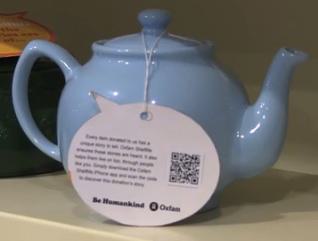Once upon a time…Oxfam and Remember Me
I’m one of those people who can’t visit a charity shop without picking up a handful of books. And I’m always on the lookout for a ‘find’ – a bargain piece of vintage clothing that I know no one else will have. So I wish I’d visited the Oxfam shop on Whitworth Road, Manchester in May 2010 when shopping was magically transformed into a treasure hunt.
- Written by
- Aline Reed
- Added
- February 12, 2015
Now here’s the clever bit. There wasn’t anything different in the shop’s stock – there was the usual mix of clothing, books, accessories and ornaments. But 40 of these objects came with a tag like this.

Intriguing.
The tag indicated that the object was part of a project called Remember Me. For five days, people were invited to record any special memories or stories attached to the objects they were donating.
Isn’t that wonderful? The shop was suddenly filled with stories.
Let’s say you’d spotted a red silk bag. You like the look of it and noticed the tag. If you’d then scanned the QR code with a Smartphone, you’d get this – a message from the previous owner.
‘It was one of the very first things I bought when I went to visit my uncle and his wife, Noy, who live just outside Bangkok. It was also one of the very first times I got a tuk tuk and I nearly fell out in the middle of a motorway on the way back.
‘So I risked life and limb to get that bag!’
The Remember Me project was good business. All the items with a story sold within five days when usually it would take weeks to sell them.
The scheme was then rolled out to 10 Oxfam shops throughout Manchester under the name Shelflife. By the look of this website it ran until 2012.
You might think this is a slightly odd looking ornament missing an arm. But read the story attached to it and it’s suddenly far more charming.

I don’t know if the project is still running and I have a slight concern that the technology might be a barrier to participation. I’d like to have seen what happened if the stories were just written on the labels and you could take them home with you. But it’s a great way of showing how a story can sell.

















